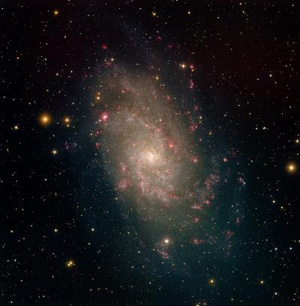What shall be the first astronomical object to grace this blog in 2011*? With a whole sky to choose from, why not use an old friend, but seen in a surprisingly new way? So I present to you the nearby Triangulum Galaxy, M33, as seen by the orbiting far-infrared telescope WISE:
Yeah, that’ll do! Click to galactinate.
M33 is familiar to pretty much any serious amateur astronomer north of the Equator. It’s not that far in the sky from its bigger buddy M31, the Andromeda Galaxy, and in fact isn’t terribly far in space either; Andromeda is about 2.5 million light years away, while M33 is about 3 million. M33 is a spiral galaxy as well, and one of the closest to us.
Andromeda is probably the most well-known galaxy in the sky. So why is M33 so less famous? Mostly because it’s smaller; Andromeda and the Milky Way are roughly the same size (so close, in fact, that astronomers have been arguing for decades over which is the beefier of the two, and the title has swapped back and forth many times), but M33 is only half our size. Also, it’s more face-on to us, spreading its light out, making it actually a somewhat tough object to see. I’ve seen it in binoculars from dark sites, but it’s only marginally brighter than the sky background.
In the WISE image, blue and cyan are from infrared light at 3.4 and 4.6 microns (roughly 5 and 6.5 times the reddest light your eye can see). That comes mostly from stars. Green and red are IR at 12 and 22 microns, much farther in the infrared, and comes from cooler material like interstellar dust, which is opaque to visible light.
 Here’s a shot of M33 in visible light. It looks a bit different than in the IR, doesn’t it? The core is bright in visible, but basically gone in the infrared. That’s a clear sign that stars aren’t being born there; they create a lot of dust when they form, and that lights up in the IR.
Here’s a shot of M33 in visible light. It looks a bit different than in the IR, doesn’t it? The core is bright in visible, but basically gone in the infrared. That’s a clear sign that stars aren’t being born there; they create a lot of dust when they form, and that lights up in the IR.
Interestingly, the overall shape of the galaxy in both images is similar. You can trace the spiral arms easily in both, and the WISE image gives you a pretty clear view of where stars are forming. Those bright spots in the the IR shot look like stars, but are pinkish in the visible image, which marks them as gigantic gas clouds where lots and lots of stars are being made – the pink is from the presence of vast quantities of heated hydrogen gas, which shines brightly in red.
See that really bright red-tinged white blob in the WISE picture on the left, smack dab on a spiral arm? That’s one of my favorite objects in the sky, called NGC 604. Doesn’t look like much, does it? That’s because WISE, while a great observatory, actually sports a rather small mirror: just 40 cm (16 inches) across. It was designed to survey the whole sky, and not see small objects in high resolution. However, we have bigger telescopes like, say, Hubble with its 2.4 meter (8 foot) mirror:
 Boom! Yeah, now you can see why I love this object; it’s beautiful, intricate, and amazing. NGC 604 is a vast star-forming factory well over 1500 light years across, much bigger even than our own Orion Nebula (which itself is pretty dang big). NGC 604 is so big and bright that were it located as close as Orion, it would be second only to the Moon as brightest object in our night sky!
Boom! Yeah, now you can see why I love this object; it’s beautiful, intricate, and amazing. NGC 604 is a vast star-forming factory well over 1500 light years across, much bigger even than our own Orion Nebula (which itself is pretty dang big). NGC 604 is so big and bright that were it located as close as Orion, it would be second only to the Moon as brightest object in our night sky!
One other thing about the WISE picture: it’s pretty big. At about 1.5° on a side, over 11 full Moons could fit in this shot! It would take Hubble weeks to take a picture covering that much sky. I’ll note that WISE has to use a cryogen – frozen hydrogen! – to keep its instruments cold, but the coolant ran out in October. Still, it can take images in the shorter two of the four wavelengths of infrared, so it’s still up there scanning the sky. I was surprised to learn that WISE discovered more than 33,000 asteroids, over 100 of which pass near the Earth! That’s phenomenal.
I don’t know how many more beautiful pictures we’ll see from WISE, but I’m glad it’s still up there doing science and keeping its cold eye open for more potentially threatening asteroids. The more, the better.
Image Credit: WISE: NASA/JPL-Caltech/WISE Team. Visible M33: T.A.Rector (NRAO/AUI/NSF and NOAO/AURA/NSF) and M.Hanna (NOAO/AURA/NSF). NGC 604: NASA and The Hubble Heritage Team (AURA/STScI).
* Not counting the Sun, which I posted yesterday but is 1) an old picture, and b) was not the primary reason for that post.
Related posts:
- A Swiftly UV galaxy
- Galaxy on edge
- Unwind with some spirals
- The first spectacular views of the sky from WISE